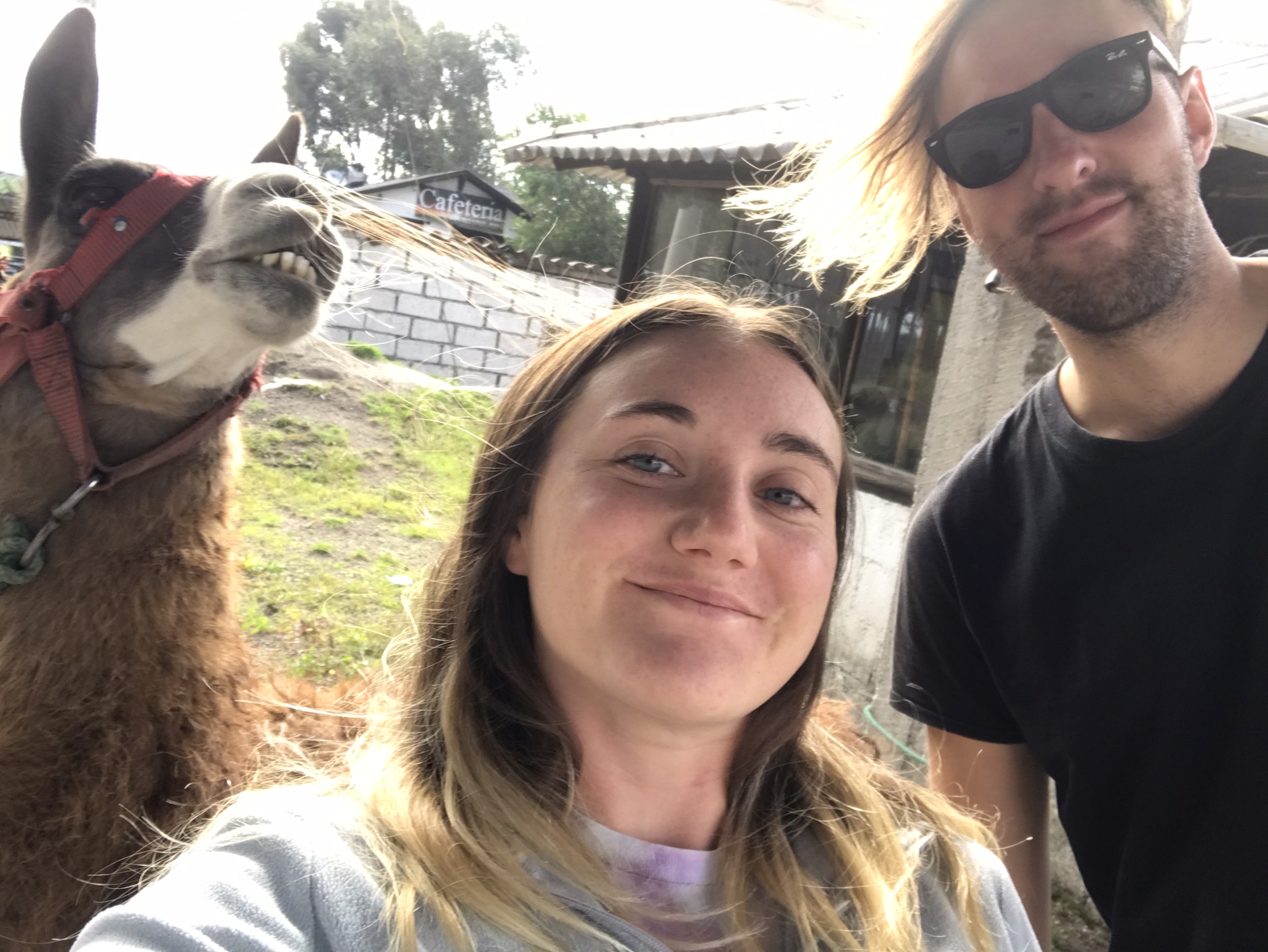The small country of Bosnia & Herzegovina is one of the most complicated in Europe, with Muslim Bosniaks, Orthodox Serbs and Catholic Croats all sharing the land. To outsiders Bosnia & Herzegovina is best-known for the brutal war that took place in the 1990s, and while the war is fresh in the minds of locals and still defines the country today, there is also plenty of other interesting culture, history and nature on offer.
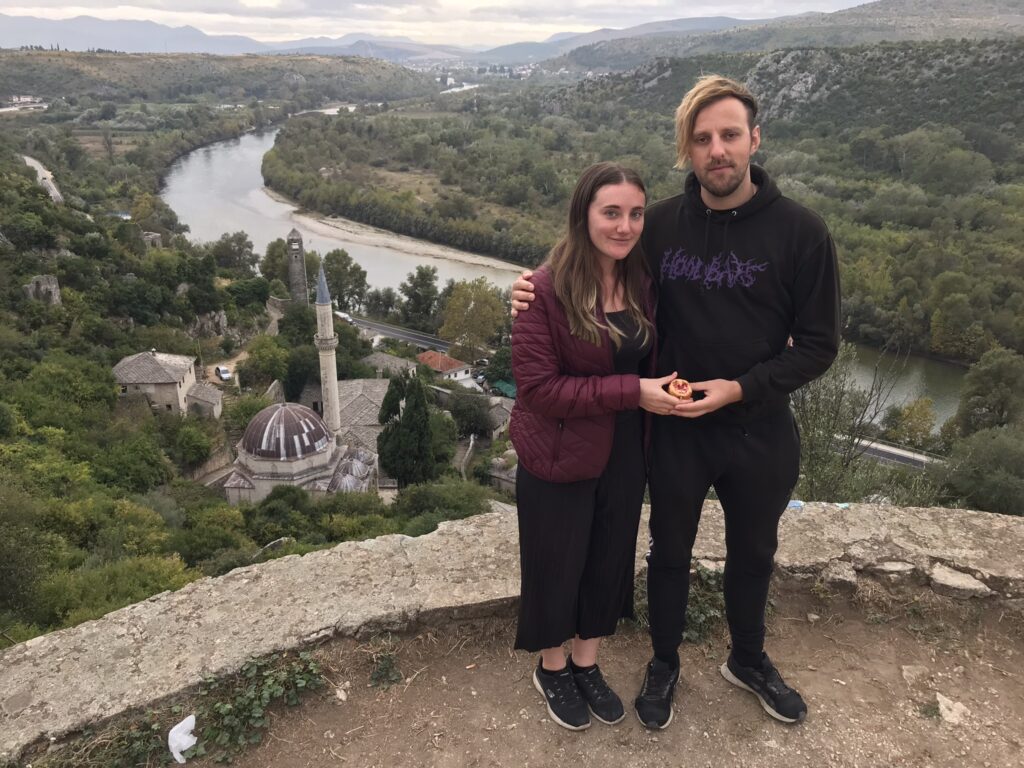
Bosnia & Herzegovina is a rich green land filled with rivers, lakes and mountains. Interestingly, Bosnia & Herzegovina only has 12 miles of coastline on the Adriatic sea at Neum. We passed through Neum on route to Mostar from Dubrovnik; from a quick glance out of the window it definitely looked like a seaside resort town.
Due to the complicated history of the country, Bosnia & Herzegovina has a very unusual political structure. Did you know there are two parts of the country – the federation of Bosnia and Herzegovina and the Republika Srpska, which is an autonomous region in the north of the country home to mainly ethnic Serbs? Bosnia & Herzegovina itself is of course made up of Bosnia in the north and Herzegovina in the south, although this is more of an unofficial demarcation and there is no official boundary between the two.
Bosnia & Herzegovina was centre-stage in the early 20th century as the location of the assassination of Archduke Franz Ferdinand in Sarajevo, which was the spark that started World War 1. Bosnia & Herzegovina was then part of the federation of Yugoslavia, until the bloody and brutal Bosnian War in the 1990s for which the country is still best known internationally today.
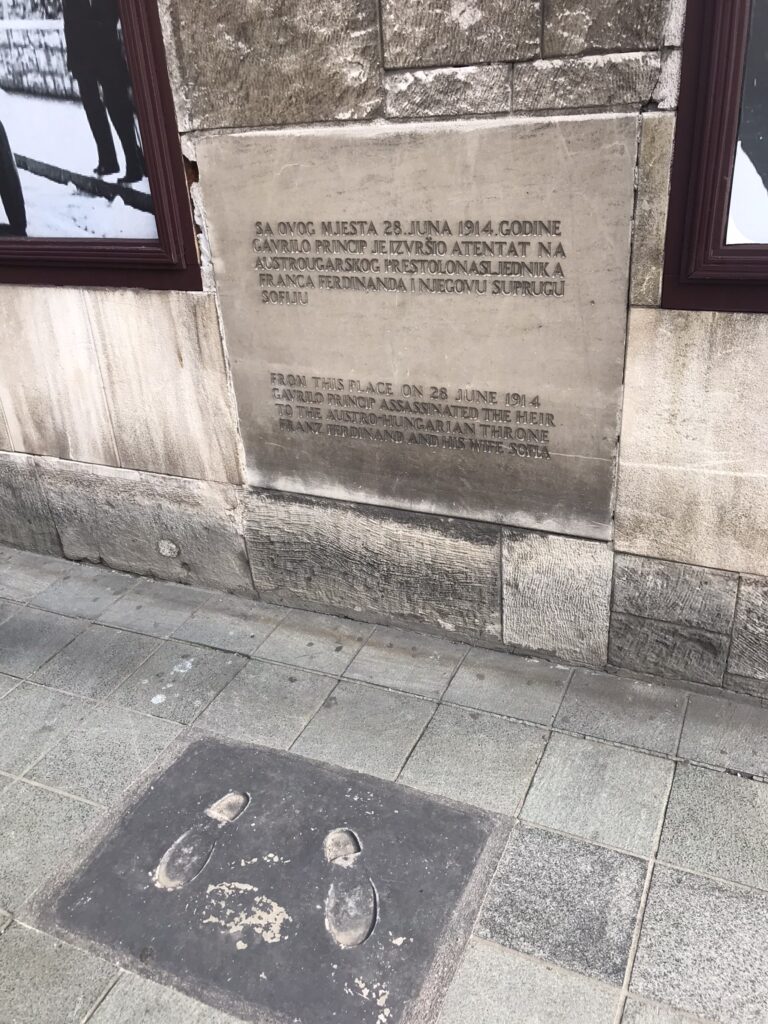
Stand in the shoes of Gavrilo Princip in Sarajevo as he assassinated Archduke Franz Ferdinand, kickstarting WW1
Bosnian War
Bosnia and Herzegovina’s recent history is synonymous with ethnic cleansing and genocide. When you mention Bosnia and Herzegovina, the first thing most people think about is the Bosnian War. I wanted to include a quick summary of the facts in this conflict as it is important for understanding most aspects of life in the country right through to the present day.
Bosnia and Herzegovina is a puzzle board of different ethnicities. The three main ones are Bosniaks (Muslim), Serbs (Orthodox) and Croats (Catholic). With the collapse of Yugoslavia, ethnic tensions were once again ignited, leading to the Bosnian War (1992-1995). Local people took up arms against one another by joining army units, whilst others were complicit or directly involved in ethnic cleansing campaigns. This conflict pitted neighbour against neighbour and families against each other. Bosniaks, Serbs and Croats lived together in the same neighbourhoods and intermarriage was common. It’s a very raw wound for those who lived through it. People are still very sensitive about talking about the war.
The conflict essentially boils down to the fact that each ethnic group wanted to control ethnically homogeneous territory within the country. Serbs wanted to create the Bosnian Serb state of Republika Srpska whilst Croats wanted to form their own Croat state. Bosnian Serbs formed the Army of Republika Srpska to fight against the Army of the Federation of Bosnia and Herzegovina (mainly Bosniaks) and the Croatian Defence Council (supported by Croatia), they received logistical and tactical assistance from the Yugoslav People’s Army under the leadership of Slobodan Milošević. It’s widely accepted that the Army of Republika Srpska committed ethnic cleansing of Bosniaks and Croats within the territory they occupied. The Army of Republika Srpska set up concentration camps for non-Serbs and subjected prisoners to inhumane treatment, torture and rape. Major events include the Siege of Sarajevo, continuous shelling and indiscriminate sniper shootings in Sarajevo between 1992-1996 which resulted in thousands of civilian casualties, and the Srebrenica massacre in 1995.
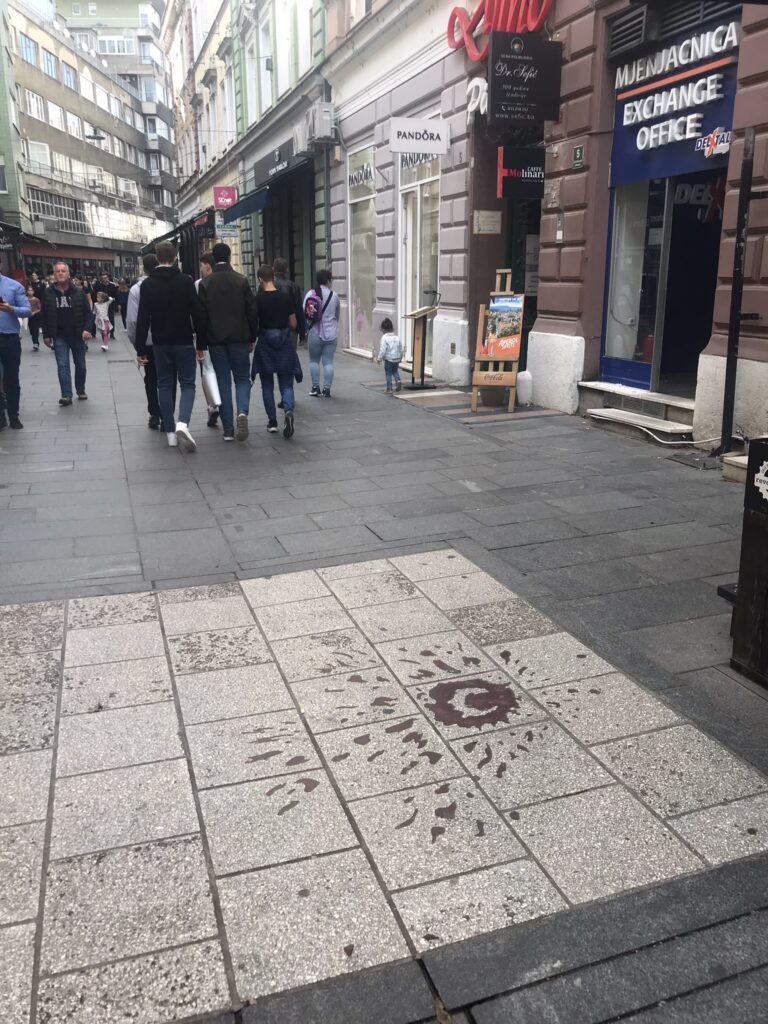
Bloodstains mark spots that civilians were killed during the Siege of Sarajevo
The Srebrenica massacre drew international attention to the war from across the globe, over 8000 Bosniak men and boys were massacred in the town of Srebrenica after it was attacked by the Republika Srpska Army in July 1995. The most controversial and shocking part of this is that the town had previously been declared a UN ‘Safe Zone’ and offered safe refuge to Bosniak civilians caught in the conflict. The Dutch UN detachment had to withdraw from the city which led to the mass killings. Civilians swarmed to the UN base to beg for protection but were told to evacuate the premises. It’s interesting to note that graffiti found from these UN soldiers shows that some of them held derogatory, racist views about Bosniaks especially Bosniak women. In order to hide their crimes the Republika Srpska army reburied the bodies in secondary and tertiary mass graves. The disturbance of the mass graves by heavy machinery resulted in bodies being jumbled up, it was very rare for a complete skeleton to be found; some families were only able to bury a single bone of their relative or nothing at all. In some cases, female relatives of the murdered Bosniak men and boys spent years trying to find the bodies of their relatives; some never have. Some cannot find peace still to this day not knowing what happened to their brother, son or husband or where they’re buried. It’s a very sad reality. It’s possible to visit the Srebrenica memorial as part of a tour group or travel there independently, we decided against this as we thought Gallery 11/07/95 in Sarajevo provided enough of an overview of the events.
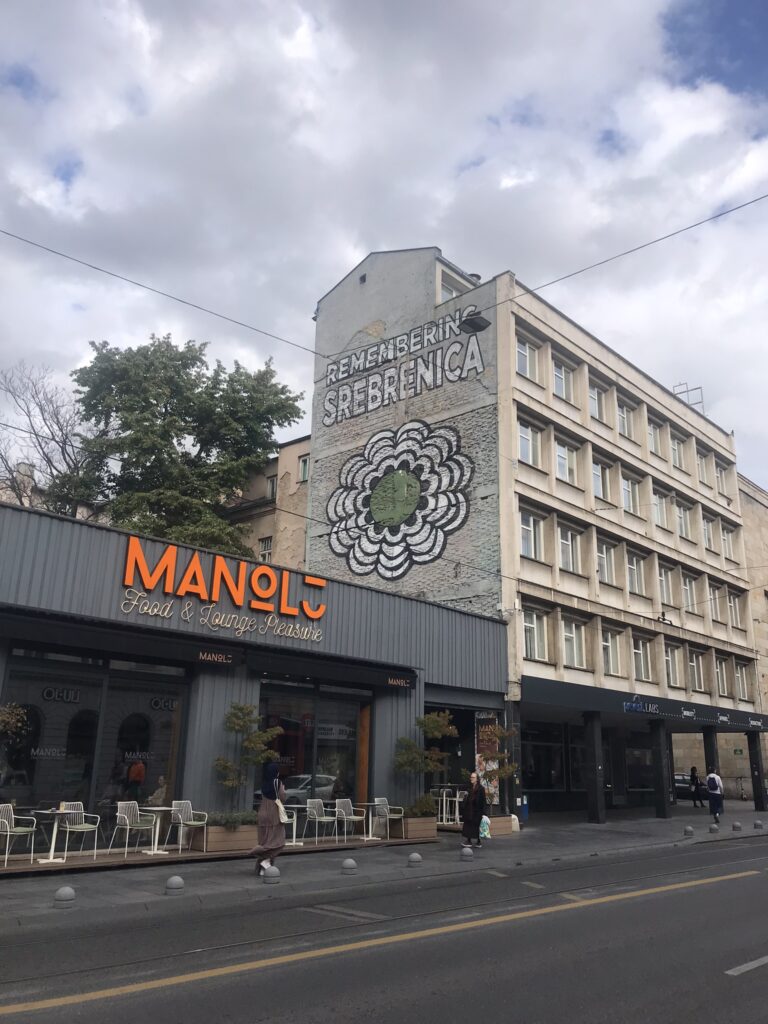
Artwork on the theme of remembrance is everywhere in Sarajevo
Over 100,000 people were killed during the Bosnian War and 2.2 million displaced. All sides were guilty of atrocities; at the International Criminal Tribunal in the Hague in 2008, 45 Serbs, 12 Croats, and 4 Bosniaks were convicted of war crimes.
The current political situation is complicated in Bosnia and Herzegovina. There are three incumbent presidents each representing an ethnic group, these figures often clash on political issues or refuse to cooperate on matters which slows down and sometimes halts proceedings altogether. Change is slow to come about in Bosnia and Herzegovina due to this constant political wrangling. The Serb president still refuses to acknowledge the atrocities committed during the genocide which is a major blockage to Bosnia and Herzegovina trying to achieve admittance to the European Union. Most Bosnians we spoke to were unhappy with the inefficient political system in their country, although they were at least happy to now be able to live in peace.
Mostar
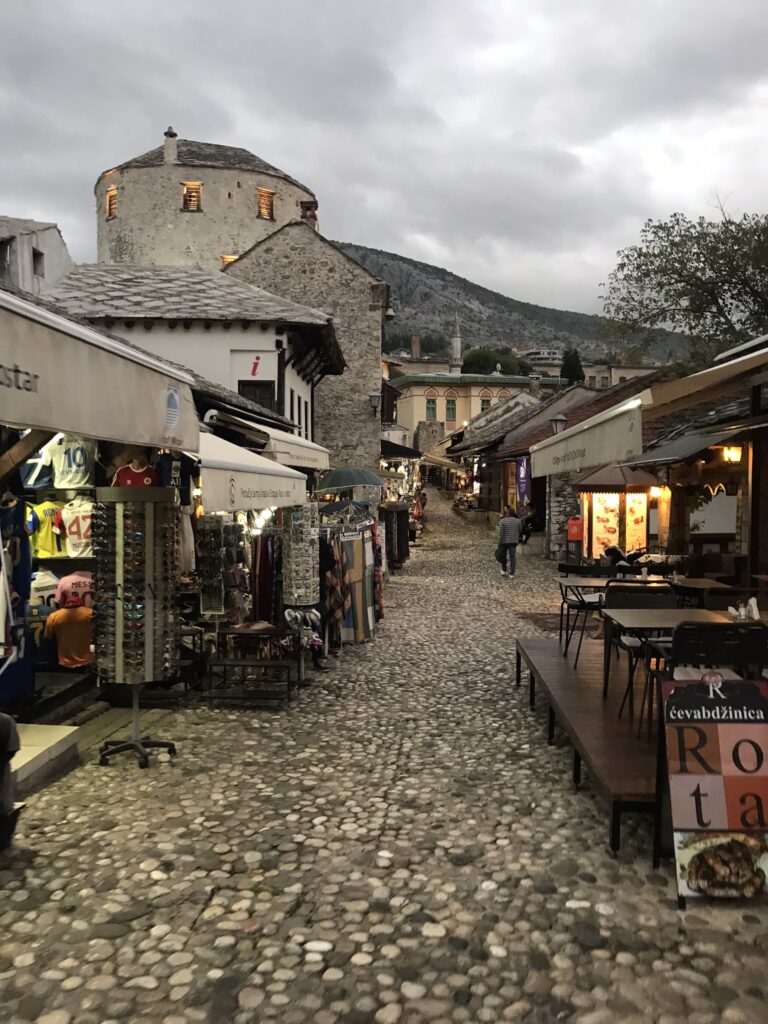
Residents consider themselves Herzegovinians rather than Bosnians here. The region of Herzegovina was named after a 15th magnate called Stjepan Vukčić Kosača, who gave himself the title of Herzog, the German word for Duke.
Mostar is famous for its iconic 16th century bridge, which locals refer to as Stari Most, spanning across the Neretva river. If you’re lucky you might even see a local jumping from the bridge. The bridge sits at the heart of the city’s historic centre, which is very picturesque with cobbled streets. Outside of this area the rest of the city is not so pretty, with many prefabricated concrete buildings, some of which are still showing damage sustained during the Bosnian War. The city can be quite busy during the day with many day trippers visiting on coaches, and the historic centre and bridge could become a little overcrowded at times when we were visiting even though we were out of the peak season. At night, most of the tourists returned to their cruise ships and the old town was quiet and peaceful.
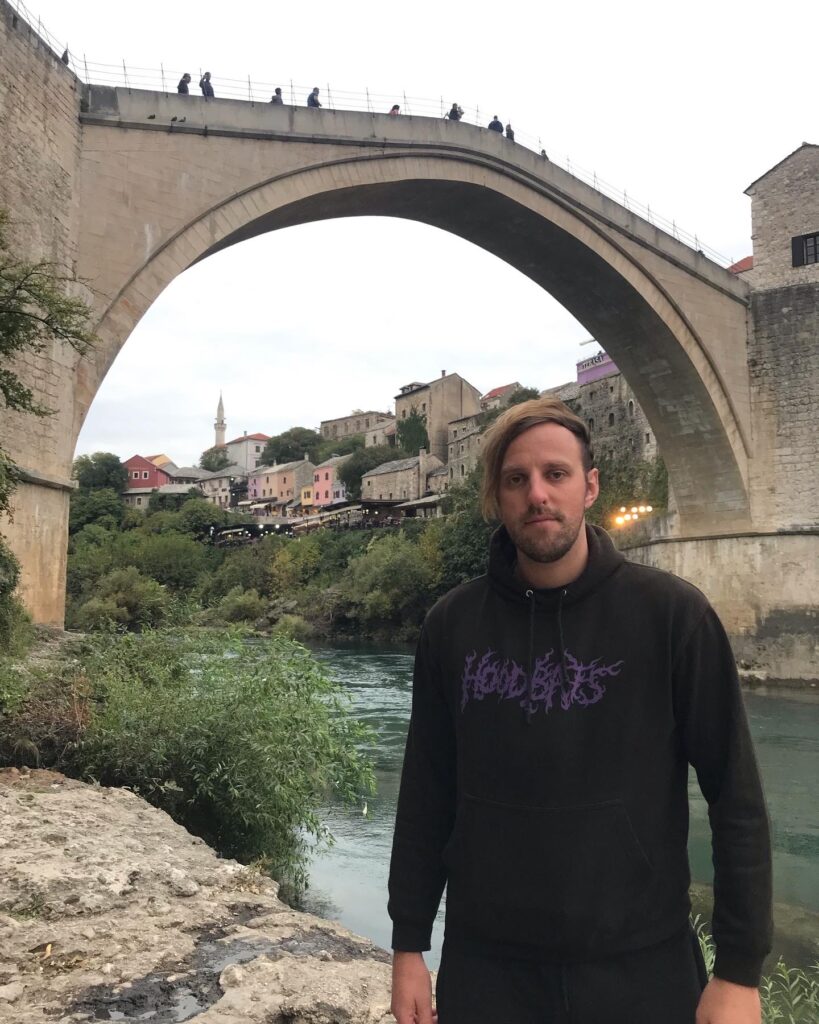
The best place to snap a photo of the Stari Most is at ‘Beach below Stari Most’, you can also book a speedboat trip along the river Neretva from this beach
Jumping from Stari Most is a local tradition for Mostar residents, there’s even a diving competition in the summer. The bridge jumpers are experienced pros, it’s very important to know how to jump, where to aim for in the river and to make sure you’re capable of swimming in the strong currents. There’s a jumping club at one end of the bridge which includes a gift shop; if you want to complete a jump from the bridge yourself (if you’re crazy enough that is) you can organise coaching from a professional local jumper for a fee and they’ll guide you through the process with practise jumps on a nearby diving board. When we visited in October, there was a local jumper from the club who waited on the bridge until he’d collected enough money before he made the jump. We didn’t hang around to see the jump as it took a while for him to collect the right amount of money. The bridge jumping club is very tourist-oriented but still pretty cool to watch. It’s important to note that Mostar bridge was destroyed during the Bosnian War; the current bridge is a modern replica.
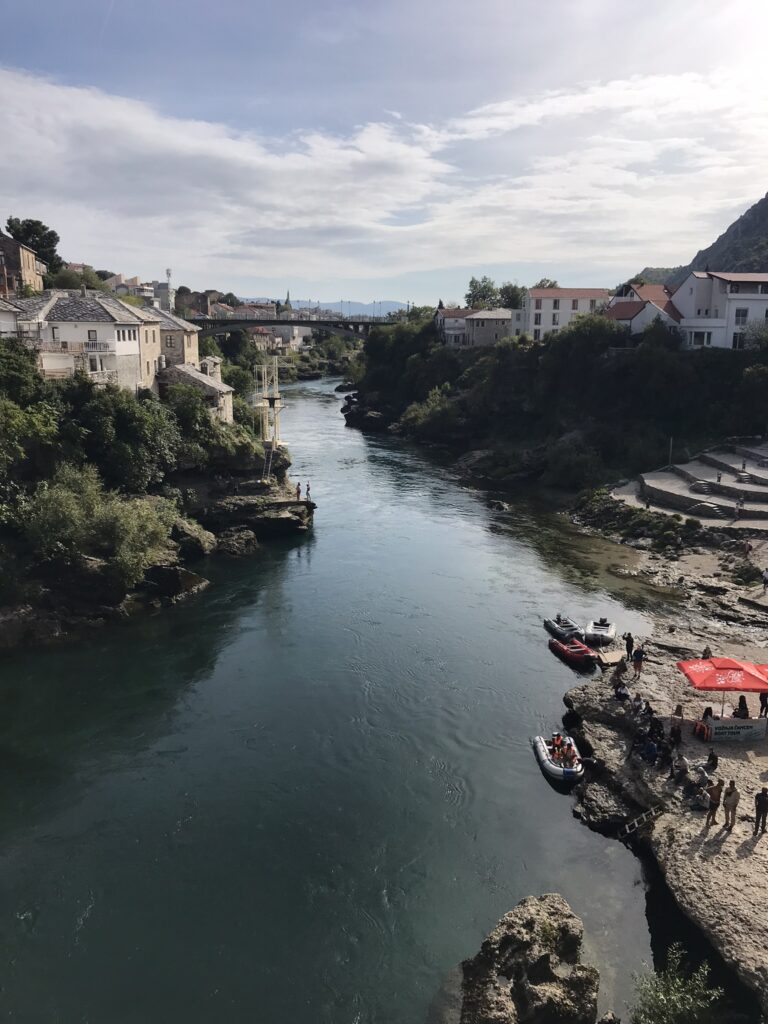
The view from Stari Most on a clear day is fantastic!
Stari Most is quite slippery due to the polished stones lining the walkway, we witnessed more than a few tourists almost fall over on the bridge. It’s not great if you’ve got mobility issues or are wobbly on your feet. I would avoid the bridge altogether in the rain if possible. If you’re walking from the bus station across the river via Stari Most, watch out for the cobblestones in the Old Bazaar area. We made this mistake and really struggled to get across the bridge to our accommodation with a wheelie suitcase. Our walking tour guide said that to be a proper Mostar-ian you need to be able to do three things: jump from Stari Most bridge, walk in high-heels through the Bazaar area (incredibly difficult with the uneven cobblestones) and be able to light a cigarette in the strong winds.
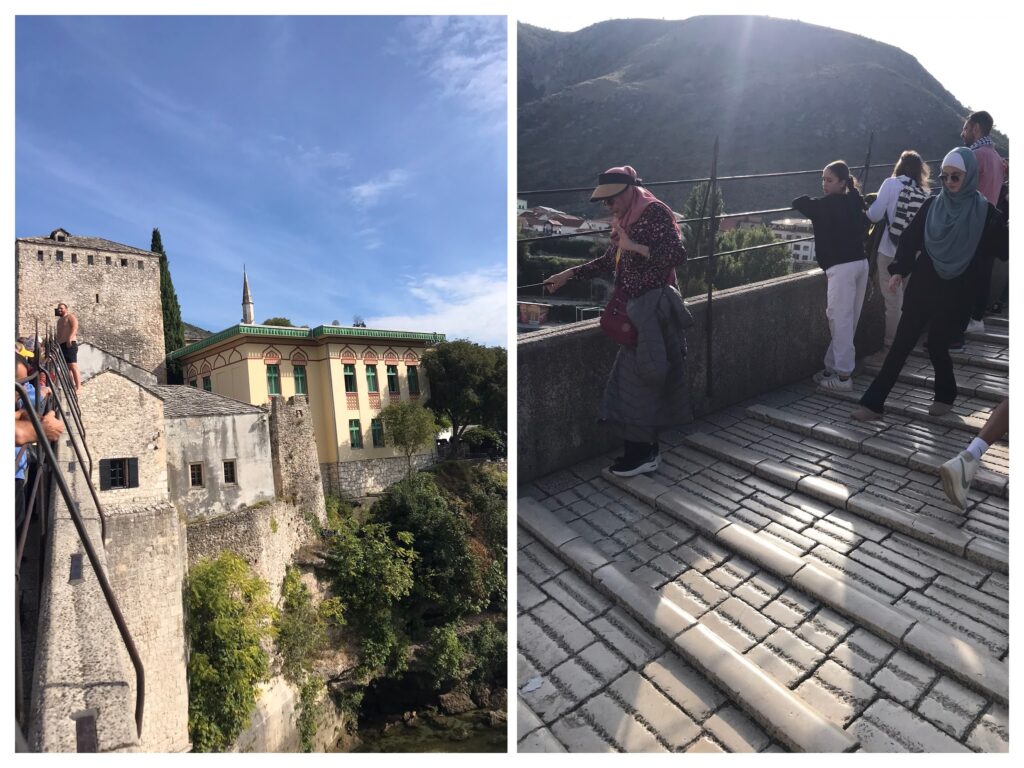
Spot the man about to jump from the bridge
Accommodation
Elegant Studio Apartments Lasta on Booking.com – a lovely modern apartment with kitchenette, ideal for a couple.
Foodie Places
Podrum – I can’t fault this restaurant. The prices were affordable, especially as it’s located on the main street, while the quality and service were fantastic. Meat, meat and more meat on the menu!
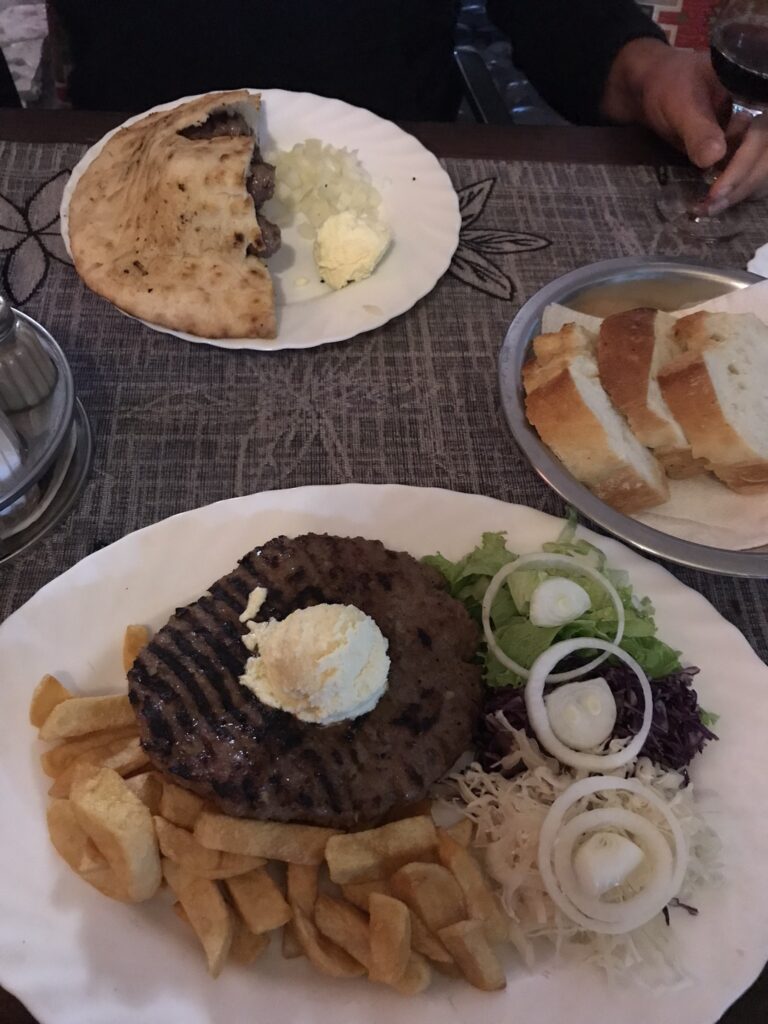
Podrum was the first place I discovered kaymak, it’s similar to clotted cream and usually served on a huge meat patty; I was instantly hooked.
Porto Pizza Mostar- a great local pizza restaurant with an english menu. Locals seemed to be continuously chain-smoking in the restaurant, it’s okay as long as you aren’t bothered by cigarette fumes by nearby tables.
Food House Mostar – slightly more on the expensive side, this place served traditional food but felt a tad more touristy than Podrum and Porto.
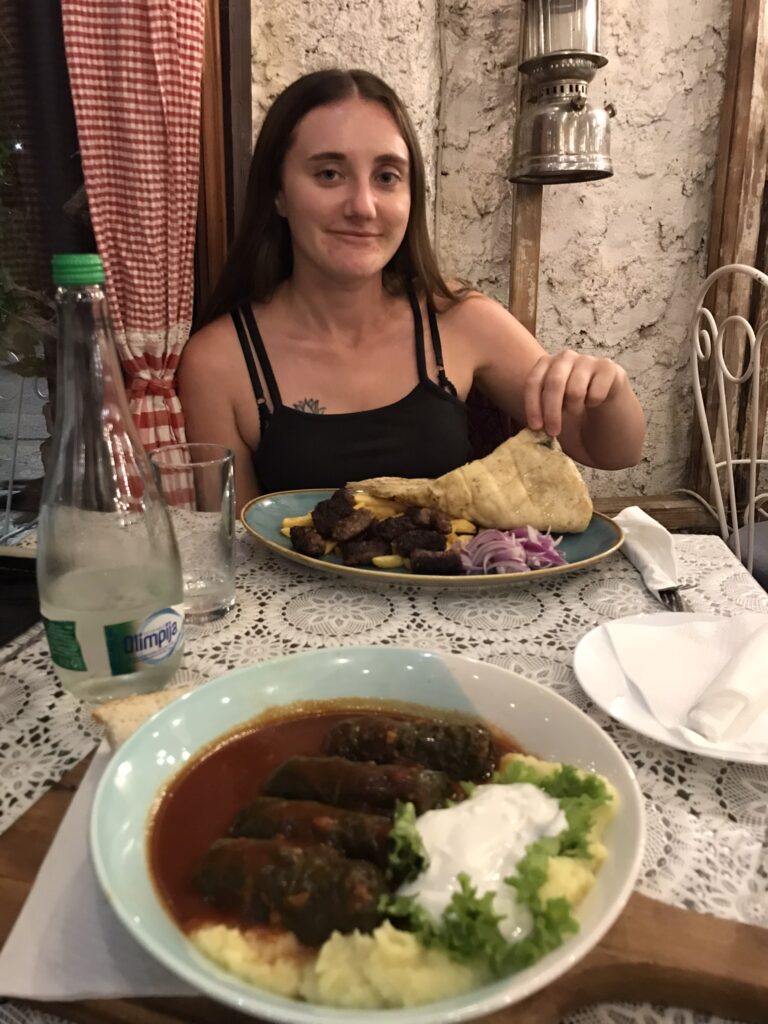
Food House Mostar serving up the goods
Activities
Free walking tour with Guruwalk with stops including the Hammam Museum, Stari Most, Kriva ćuprija (another bridge close to Stari Most), Koski Mehmed Pasha Mosque, Nesuh-Aga Vucjakovic Mosque and Old Bazaar. This walking tour with Arnela was one of the best we’ve ever been on, the guide was knowledgeable, approachable and willing to talk about her own experiences during the Bosnian War. It was a powerful and enlightening experience. The final stop was next to a graveyard filled with the graves of civilians and combatants of all ethnic groups killed during the conflict. We were saddened to see some small infant graves amongst the others.
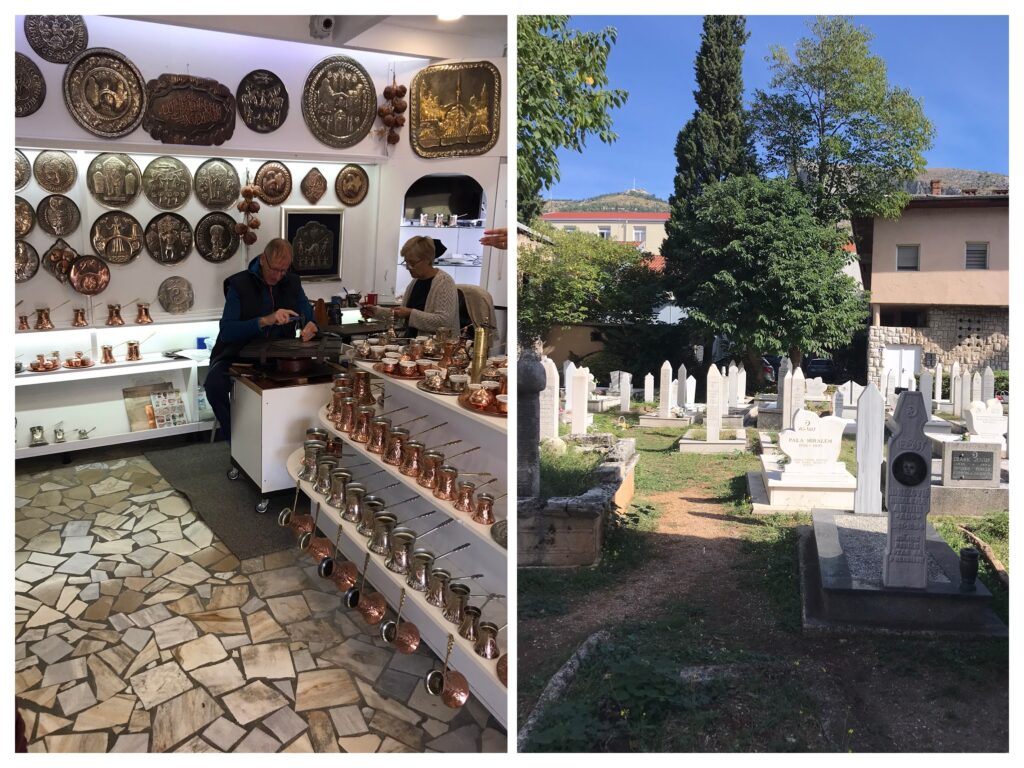
On the walking tour with Arnela
Old Bazaar – filled with souvenir shops and more traditional copper-working workshops, during our walking tour we were introduced to one shop-owner/artisan and he gave an interesting demonstration on copper-working, showing us how to create copper plates, jewellery and coffee sets. Many of these workshops are family-run businesses and have remained in the same family for decades.
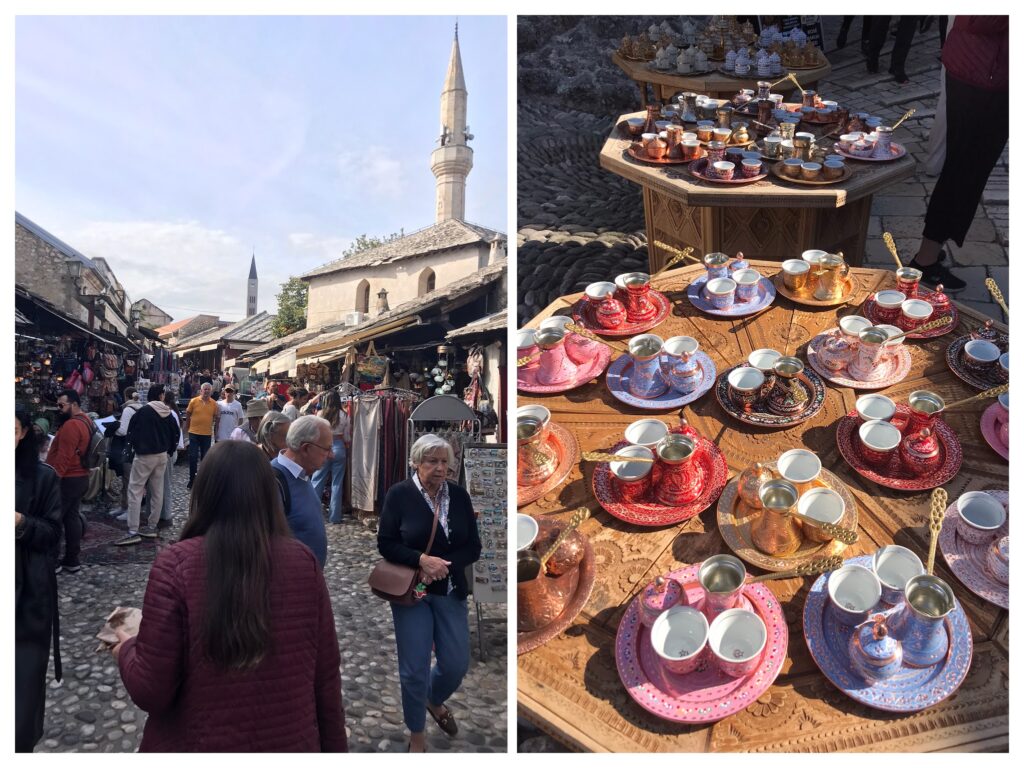
The Bazaar is a great place to shop for souvenirs – make sure you check out the authentic copper-working shops.
Wine tasting at the Spirit of Herzegovina – situated within a stones throw of Stari Most, it’s a great spot to taste local wines and absorb the bustling atmosphere. We particularly enjoyed watching the crowds hurry past and the transition from dusk to dark, with the twinkling lights of the Stari Most bridge.
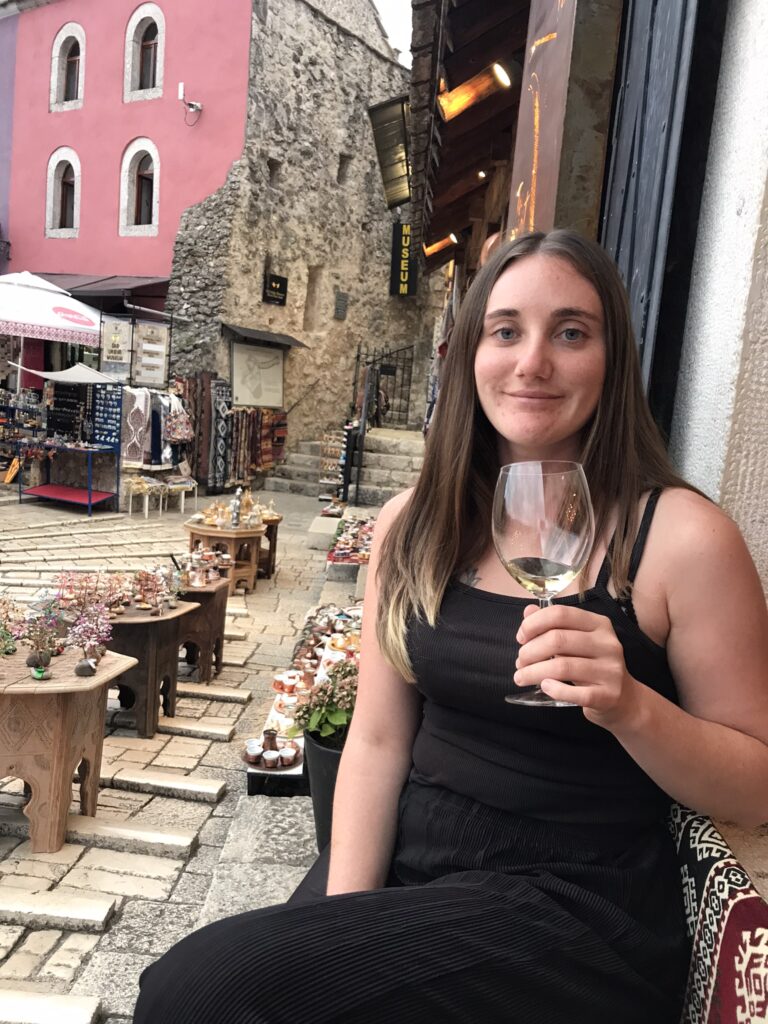
Sipping on Herzegovinan wine at Spirit of Herzegovina – the owner is very friendly too!
Sniper Tower – we stopped here briefly on our way to the bus station. It’s now just an abandoned concrete building with some street art but it was used as a sniper spot during the Bosnian War. You can still see signs of damage from the war like bullet holes and bomb damage, particularly on the road and pavement below the tower. This is an abandoned building, although entering is possible by jumping over a wall this is trespassing and would probably be frowned upon, I also don’t recommend this for safety reasons.
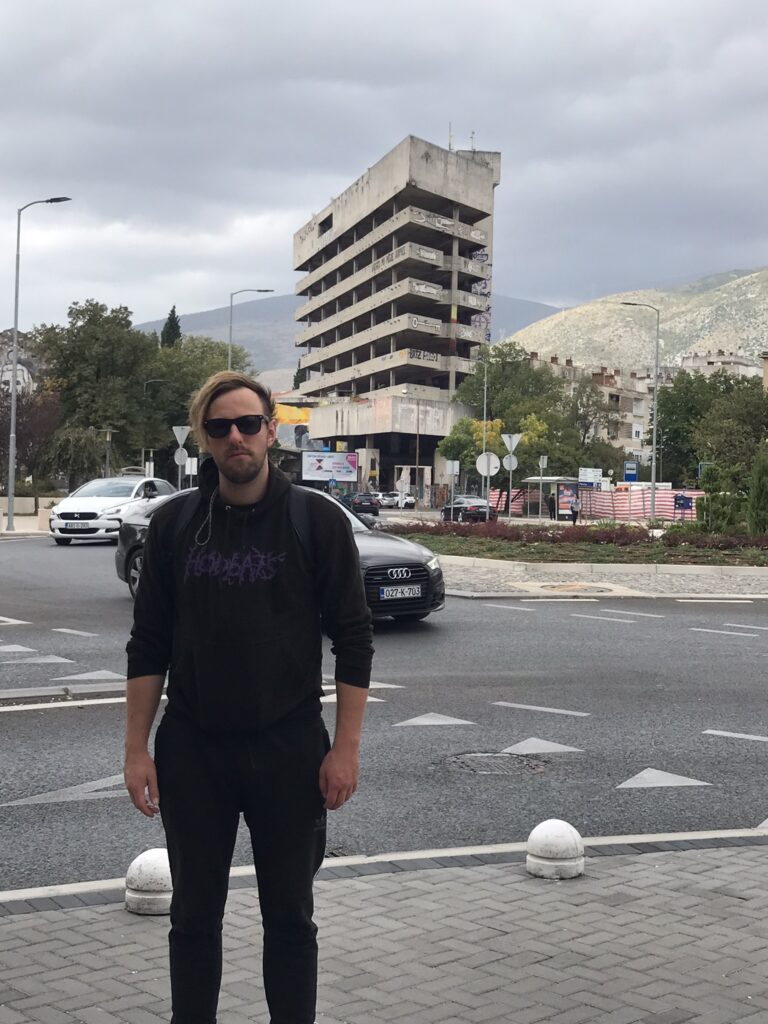
Keeping our distance from the sniper tower in Mostar – it’s important to be respectful.
Mostar Marriott Hotel – an eerie, half-finished luxury hotel that’s now boarded up and deserted. Definitely worth a peek if you’re in the area although I wouldn’t recommend trying to go inside.
Herzegovina Tour with iHouse Travel. Stops include Kravice Waterfall – you have two options to get to the waterfalls, you can either take the train down to the waterfall or trek instead. It’s not a difficult or challenging hike at all, just follow the path; I might be tempted to take the train back up to the top if it’s a very hot day. Out of season, most of the restaurants are closed by the waterfall and I would recommend bringing your own lunch if you visit from October-March. The restaurants are forced to close their doors as they usually get flooded during the winter months. It’s possible to swim near the falls in a roped off area. We weren’t so lucky and ended up arriving at the same time as a group of obnoxious schoolchildren who proceeded to throw stones in the water, one boy even lost a shoe in the pools and it had to be rescued by a man with a kayak. How dramatic!
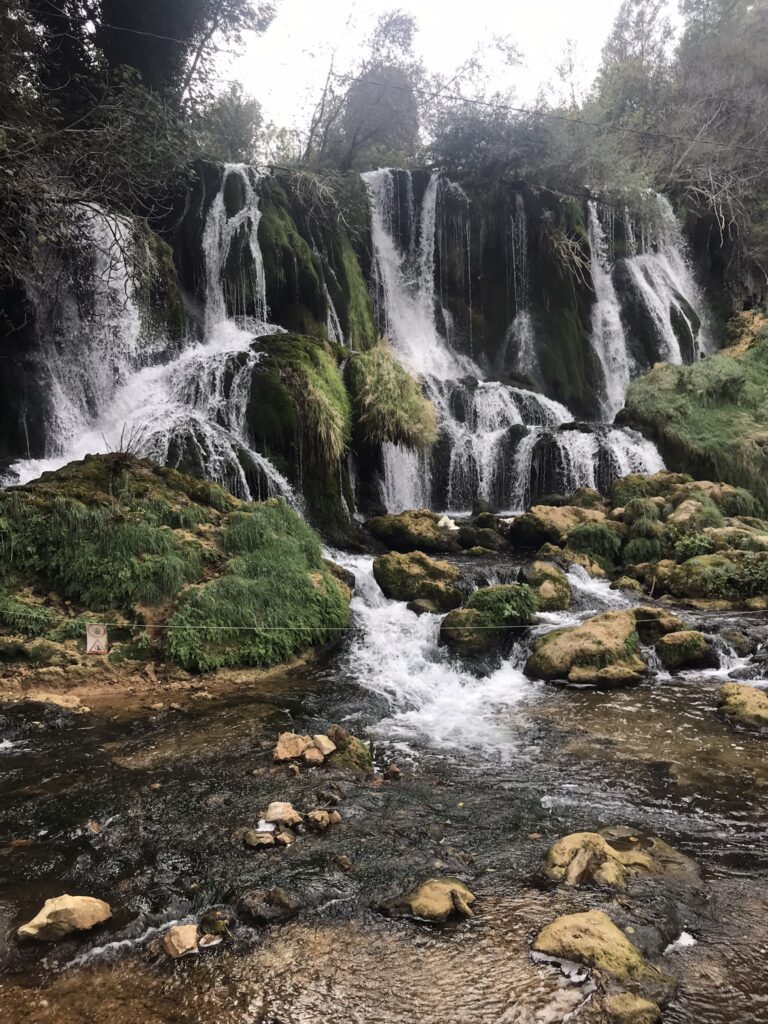
The waterfalls, minus the school group, are a tranquil and picturesque place to enjoy lunch.
Blagaj tekke – Blagaj tekke is an Sufi Islamic centre of worship nestled beneath an imposing cliff; this historic site offers an insight on the life of mystical dervishes who once lived there. It’s also a great spot for photos and you can drink fresh water directly from the spring.
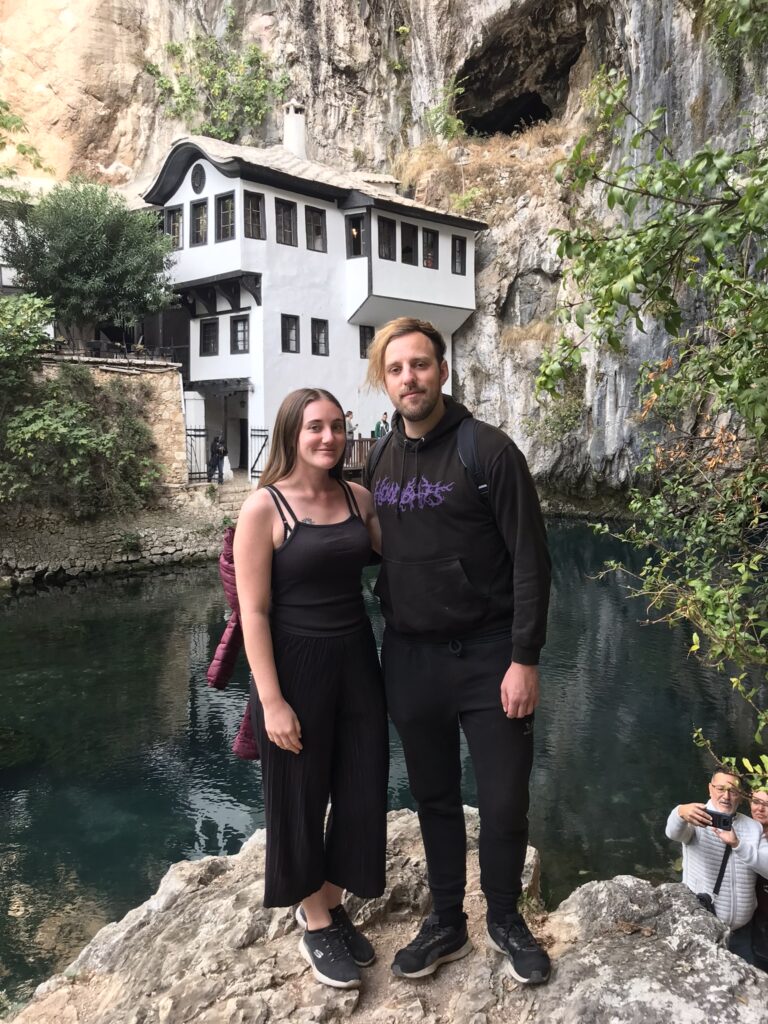
Don’t forget to snap an iconic photo overlooking Blagaj tekke
Žitomislić Orthodox Church – the original 16th century church was destroyed during the Bosnian War, the one standing in its place is an exact replica even down to the religious imagery and saints on the iconostasis.
Počitelj – great views from the top of the citadel over the valley and Neretva river below, it’s possible to meander downhill through the streets or explore the ruins of a fortress. We found the quaint village very quiet and peaceful, most residents have moved to bigger cities and left the pastoral village way of life behind. According to our guide some of the houses here don’t have electricity or running water. It’s possible to pick wild pomegranates around this village or purchase pomegranate juice made by the locals.
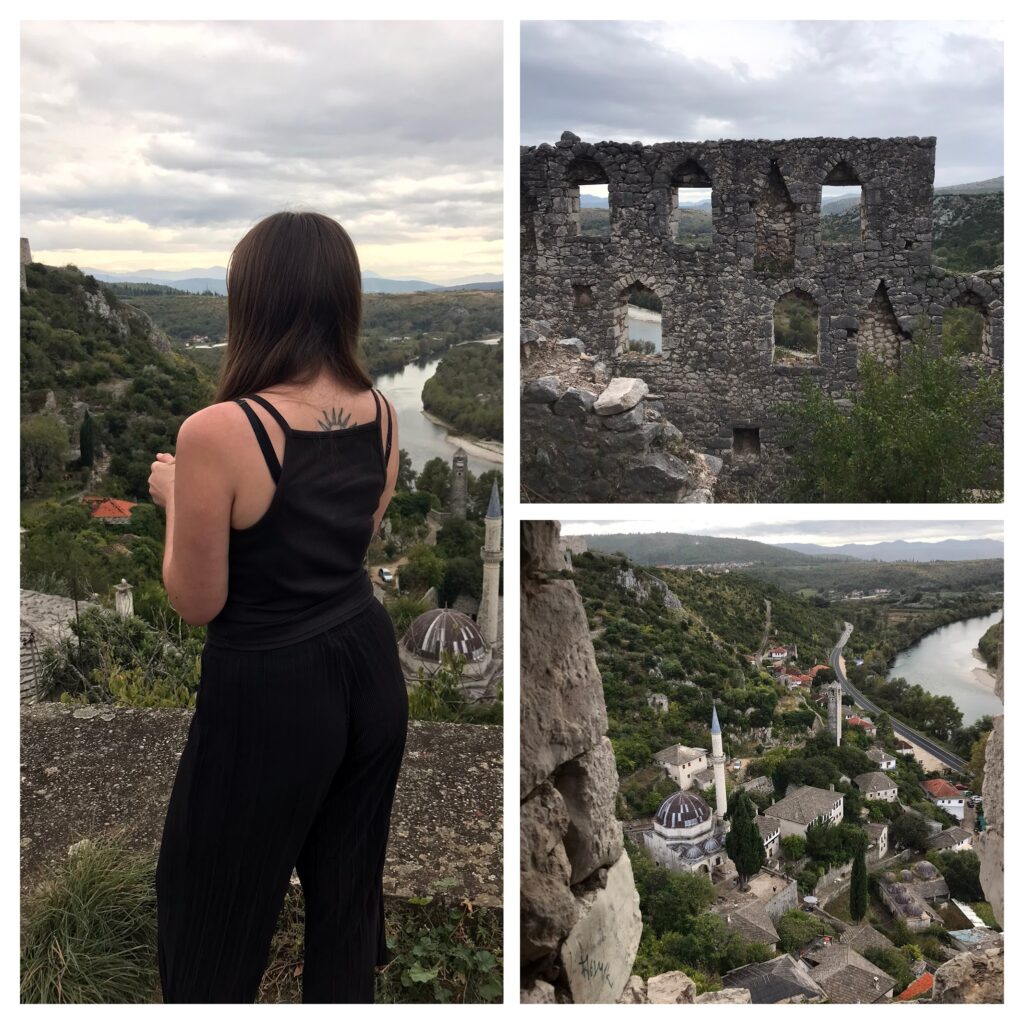
Climb to the top of Počitelj for the best views over the village and valley below
Sarajevo
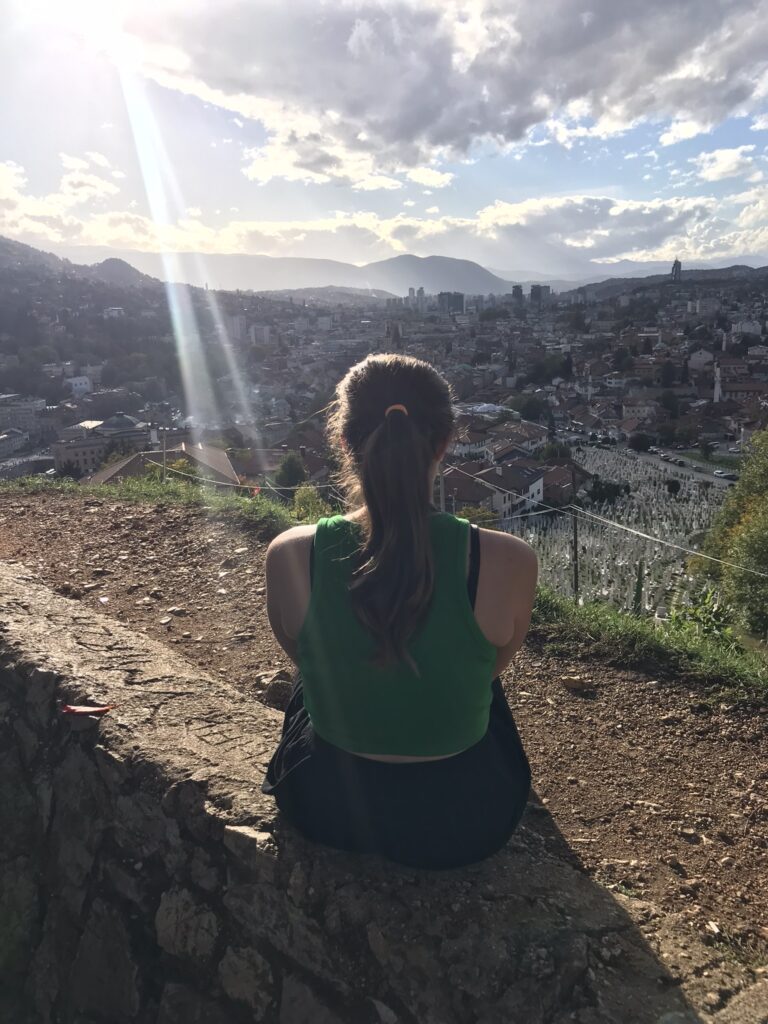
Much of modern Sarajevo is made up of faceless grey blocks, a typical concrete jungle city. In contrast, the Old Bazaar area unfurls from Baščaršija square until it touches the Miljacka river, totally distinct from a typical modern cityscape. This is the most cultural and historical part of the city and the best place to base yourself. This area is brimming with character amid the Ottoman-style streets. The Bazaar is an overwhelming delight to the senses; with the smell of grilling cevapi, endless mounds of turkish delights on display and an abundance of quaint coffee shops in prime people-watching position lining the streets.
The tram system is pretty straightforward to use in Sarajevo, we jumped on line 3 to get to Baščaršija square (I had literally no idea how to pronounce this place) from the bus station. I was shocked to see a young boy hanging on the back of the tram while it was moving, the definition of a ‘freeloader’, we came to the conclusion he was trying to bypass buying a ticket. If you’re looking to catch a bus to the airport, it’s best to wait at this bus stop and make sure you stand on the opposite side of the road to the river. This bus stop doesn’t seem legit and we were sceptical right until the bus actually arrived, but it really is the correct place. Just wait next to the kiosk there.
Accommodation
Hostel Magaza – I wouldn’t really consider this place a hostel, it was just a collection of about 5 rooms in a building behind Kovači street. The facilities were quite basic with no common room or kitchen, it’s essentially just a place to sleep. We didn’t mind so much because it was quite cheap. There are also some nice tea shops on Kovači street for chilling at the end of the day, or an Irish pub next door if you’re more of a beer drinker and want somewhere a bit more rowdy.
Foodie Places
Dženita Ur – our go-to place to eat dinner, the waiter was friendly and helpful in suggesting what to try and even let me try some fruit liquor fermenting in a jar on the counter. The prices were great and the food super tasty.
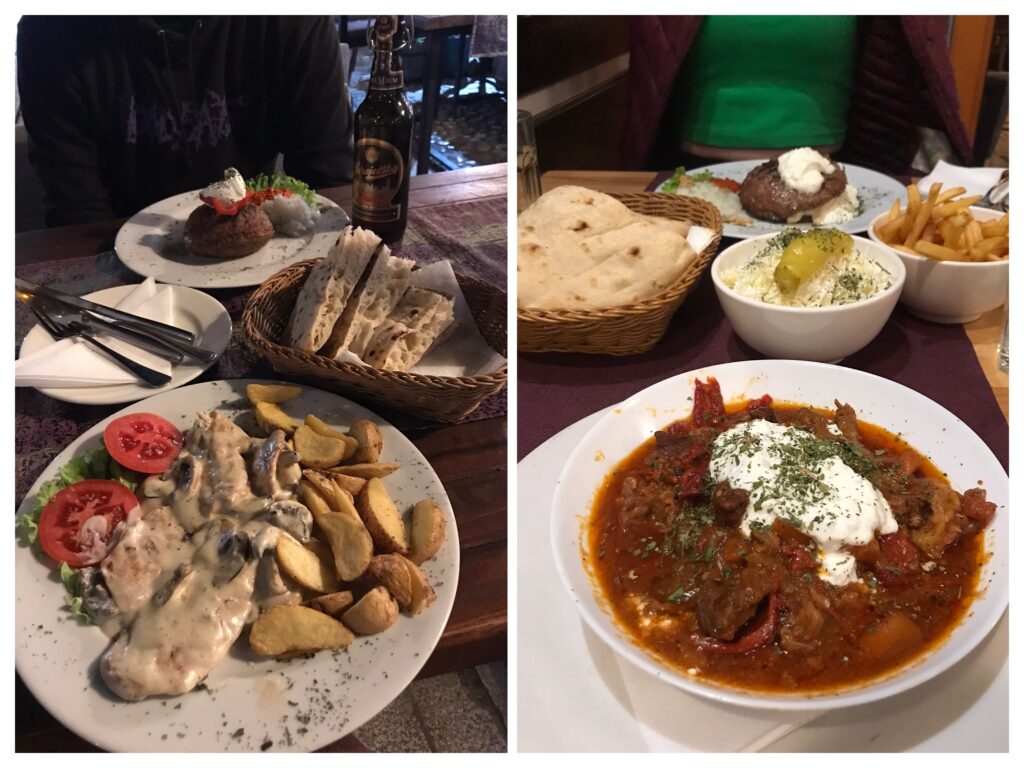
Hit up Dženita Ur for some authentic Balkan foodie delights
Ćevabdžinica Hodžić – great place in the Bazaar to try cevapi, it gets very busy at lunchtime so you might have to wait a while.
Pekara Edin – a great place to grab a quick bakery lunch, they only take cash so you need to bear that in mind.
Slatko i Slano Čaršija – Another bakery close to Baščaršija, this one takes card payments though which is handy. We sat inside the cafe to eat breakfast every morning. I couldn’t resist the cakes, especially the cream ones, they looked so damn good!
Activities
Free walking tour with Guruwalk, stops included Baščaršija square, Sacred Heart Cathedral, Cathedral Church of the Nativity of the Theotokos, Gazi Husrev-beg Mosque, Tašlihan, City Hall, the Latin Bridge, Sarajevo Museum 1878 – 1918 – outside there’s a plaque marking the exact spot the shooter stood when he assassinated Archduke Franz Ferdinand, as well as a replica car of the one that the royal couple were riding in through the streets of Sarajevo when the shooting took place.
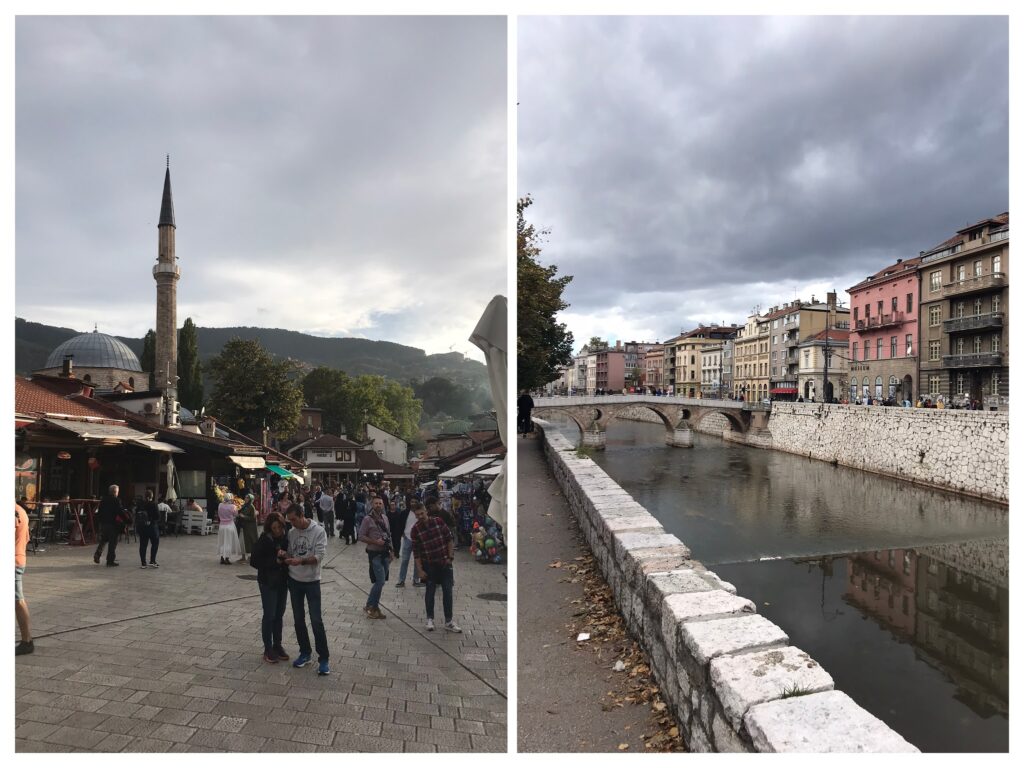
Scenery in Sarajevo
Sarajevo Meeting of Cultures – a very interesting dividing line marking the end of the Ottoman Bazaar area and the start of the Austro-Hungarian sector, the architectural styles of the buildings on both sides of the line are noticeably different.
City Hall – Sarajevo City Hall, previously a library, was damaged during the siege of Sarajevo in the Bosnian War and was lovingly restored to its former glory after the conflict ended. The exterior colour scheme and design was inspired by Moorish architecture. Inside you’ll find a magnificent stained glass roof, intricately decorated interior and various interesting historical collections.
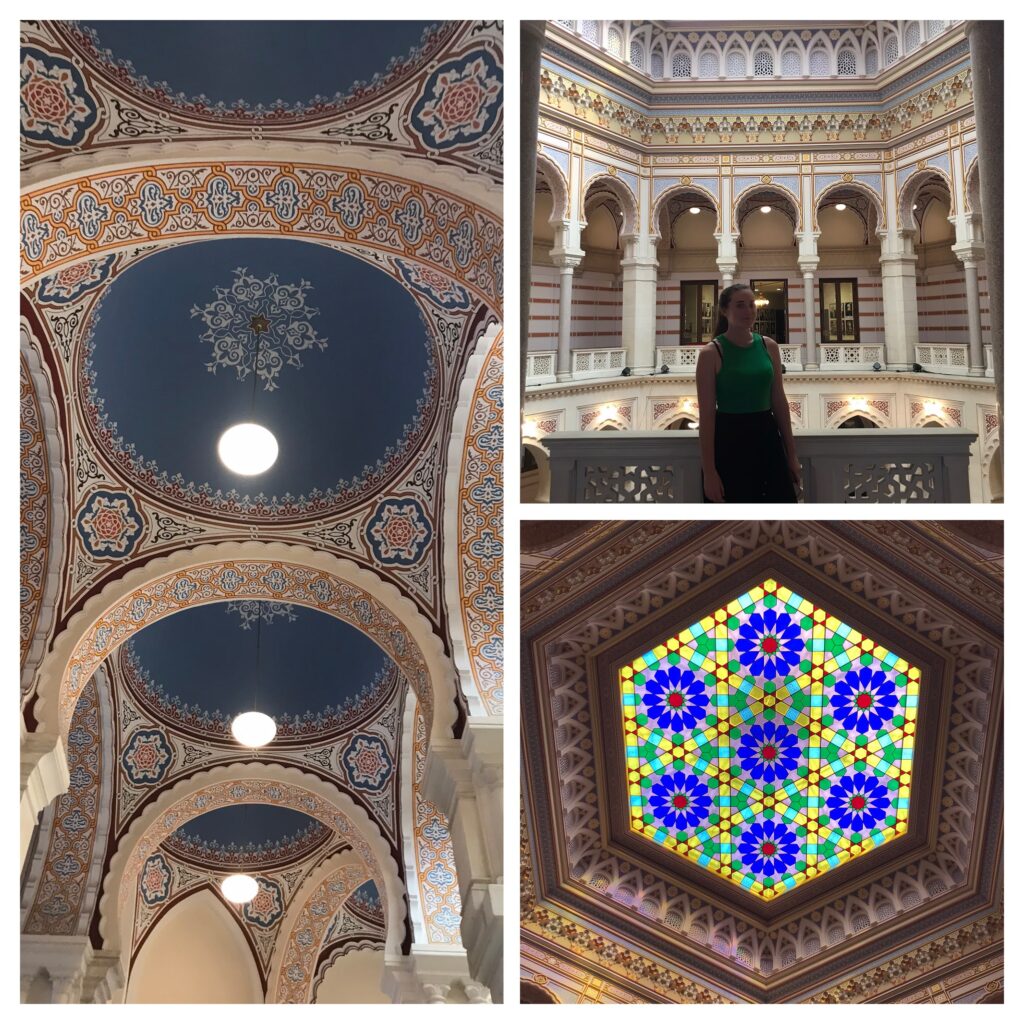
Sarajevo City Hall is well worth a visit just to look at the kaleidoscope-esque stained-glass skylight
The full court set-up from the 2008 International Criminal Tribunal, which prosecuted human rights offences during the Bosnian War, was donated to the City Hall including furniture, gowns and microphones used in the war crimes trials. The display includes information about the proceedings and outcomes of each individual that was tried by the court, alongside victims personal testimonies. There are also displays about the history of Bosnia & Herzegovina and the City Hall itself, among other things.
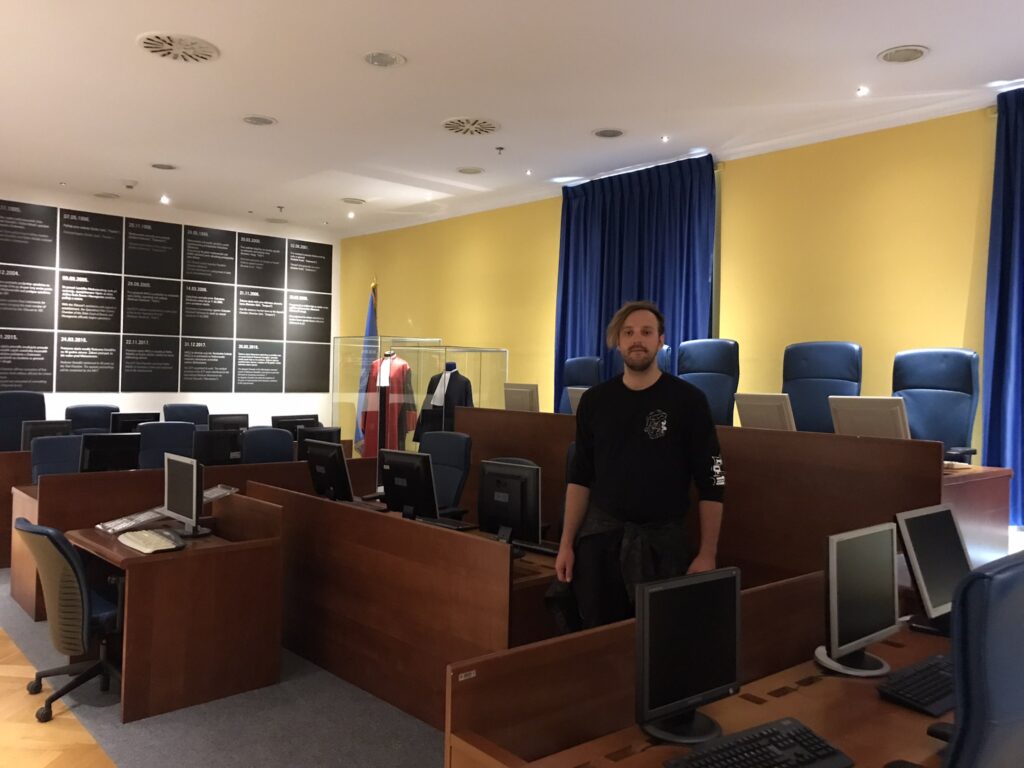
Museum of Crimes Against Humanity and Genocide – a distressing yet important testament to the victims of the war. It was shocking and saddening to read each person’s story about their experiences during the conflict. Alongside each account are personal items from the individuals involved in the narrative. Even though the museum is relatively compact, we spent more than 4 hours in two separate visits reading all the personal testimonies and information plaques. A very important place to visit if you want to understand the true horrors and reality of the conflict.
Gallery 11/07/95 – A harrowing yet powerful display of photos documenting the after-effects of the Srebrenica massacre. When you first step into the gallery, you become overwhelmed with rows and rows of photos of men and boys who were killed in the massacre. Memorable images include the large-scale excavation of bodies, the reassembly of skeletons which had been dismembered during the multiple reburial efforts, the families waiting to hear about their male relatives left in limbo, derogatory graffiti left by the Dutch UN contingent who failed to protect the safe zone, a doll placed by a villager on the site of a mass grave as to sign to excavators to dig there (this was incredibly potent as it showed that the villagers knew what was happening and where the mass graves were but didn’t intervene at the time to stop it, it suggests wilful ignorance or at worst complicity), a woman found by soldiers so traumatised she was unable to speak. The audio guide is very helpful providing additional background information about the images and context.
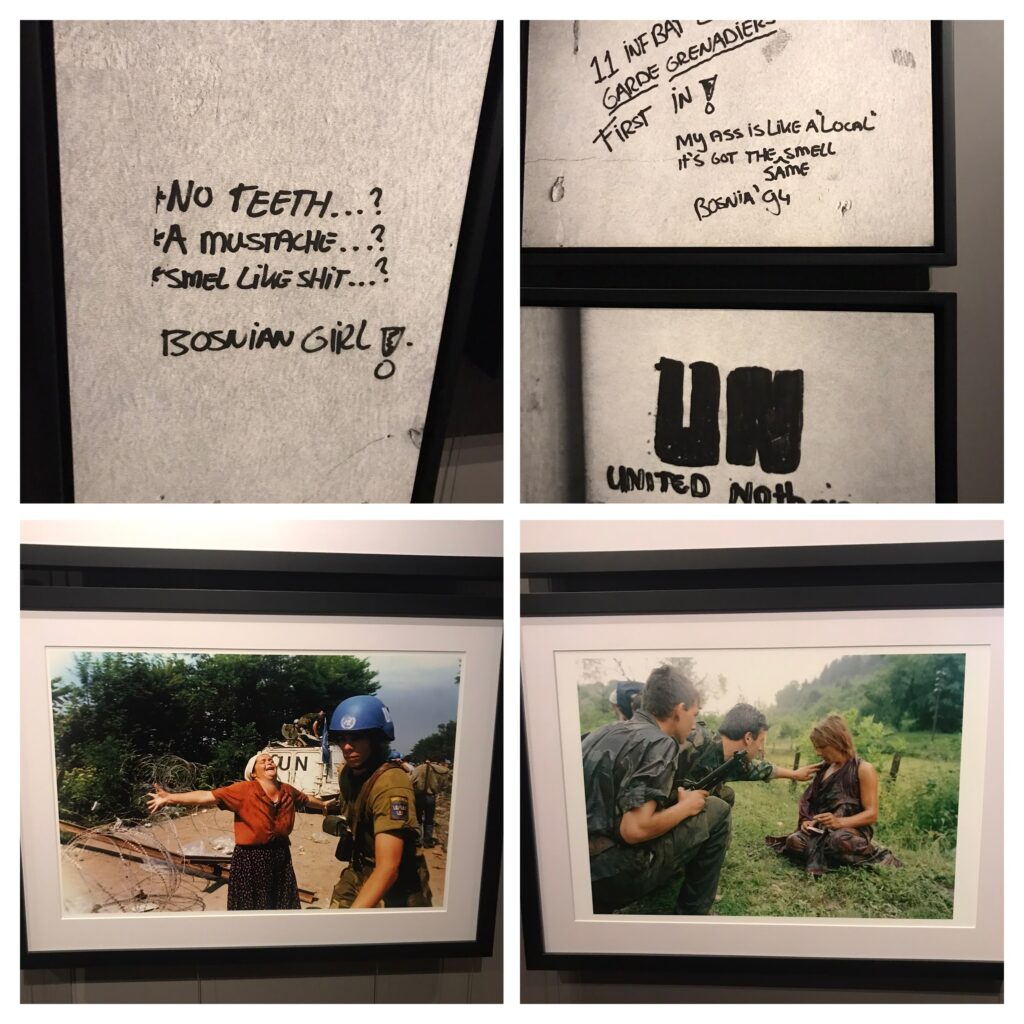
Harrowing images displayed in Gallery 11/07/95
Yellow Fortress – a great place to watch the sunset over Sarajevo, there’s quite a lot of uphill walking involved to get to the top.
